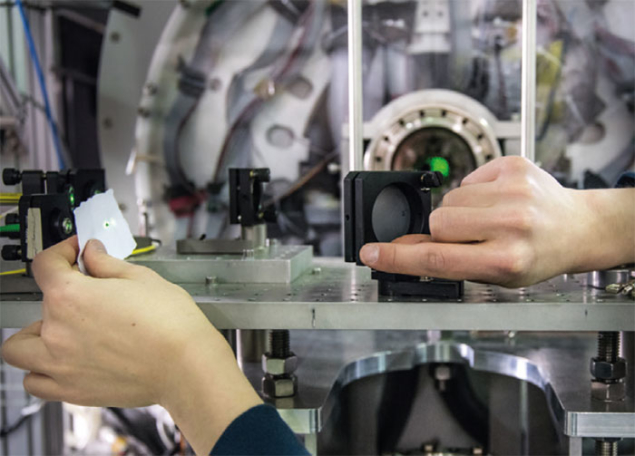
Image credit: M Brice, CERN.
Following 20 years of research and development by the CERN antimatter community, the ALPHA collaboration has reported the first ever measurement of the optical spectrum of an antimatter atom. The result, published in Nature in December, involves technological developments that open a completely new era in high-precision antimatter research.
Comprising a single electron orbiting a single proton, hydrogen is the simplest and most well-understood atom, and has played a central role in fundamental physics for more than a century. Its spectrum is characterised by well-known spectral lines at certain wavelengths, corresponding to the emission of photons when electrons jump between different orbits. Measurements of the hydrogen spectrum agree with the predictions of quantum electrodynamics at the level of a few parts in 1015, and CPT invariance requires that antihydrogen has exactly the same spectrum.
The ALPHA team has now succeeded in observing the first spectral line in an atom of antihydrogen, made up of an antiproton and a positron. The measurement concerned the 1S–2S transition, which has a lifetime on the order of a tenth of a second and therefore leads to a narrow spectral line that is particularly suitable for precision measurements. The measurement was found to be in agreement with the hydrogen spectrum, and therefore consistent with CPT invariance, with a relative precision of around 2 × 10–10.
Comparing the spectra of hydrogen and antihydrogen was one of the main scientific motivations for CERN’s Antiproton Decelerator (AD), since it offers an extraordinary new tool to test whether matter behaves differently from antimatter and thus test the robustness of the Standard Model. The ALPHA collaboration, which expects to improve the precision of its measurements, generates roughly 25,000 antihydrogen atoms per trial by mixing antiprotons from the AD with positrons. Around 14 antiatoms per trial are trapped and interrogated by a laser at a precisely tuned frequency to measure their internal states.
Low-energy antihydrogen was first synthesised by the ATHENA collaboration in 2002, later repeated by the ATRAP, ALPHA and ASACUSA collaborations, and ALPHA trapped the first antihydrogen atoms in 2010. The new result, along with recent limits on the antiproton–electron mass ratio by the ASACUSA collaboration and antiproton charge-to-mass ratio by the BASE collaboration, demonstrates that tests of fundamental symmetries with antimatter at CERN are maturing rapidly.





